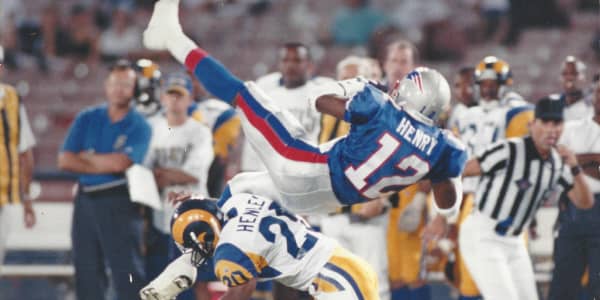
Hedge fund managers play a large role in the art market, usually by using their billionaire wealth to set new records at auctions.
Not Nelson Saiers. The former trader left Wall Street behind to become a professional artist.
Saiers, who graduated from the University of Virginia in 1997 and earned his PhD in a branch of theoretical mathematics called algebraic topology a year later, followed the path of many math whizzes in the last decade. He was a managing director for the prop trading desk at Deustche Bank, where trading in complex derivatives can lead to huge profits. He then became chief investment officer for the hedge fund, Saiers Capital.
Until he left the firm in 2014, the hedge fund was known as one of the best practitioners in the niche of volatility investing — his firm's algorithms were designed to identify when volatility in the price of an asset signaled future profit opportunities.
But having a hedge fund with his name on the door wasn't enough. Saiers said he realized he needed to make a change when he was constantly daydreaming about art in his spare time. He also cites the intangibility of his work on Wall Street and the tendency of people to compare salaries like scores as other deterring factors. "You're a gerbil in a wheel … the mark just keeps getting higher what it means to be rich."
Saiers decided to include algorithms that he wrote on Wall Street in a series of paintings completed last year. "I take this ... code and turn it into these very striking visual shapes — circles, squares, triangles — that are on the background of a lot of these Wall Street pieces," he told CNBC.
Saiers' "Inside Wall Street" series became a way for him to convey what happens in financial crises, like the ones in 1907 and 2008. "The main motivation was really to try to help people see the complexity of these products and the complexity of what goes on behind the scenes. ... It actually affects all of our lives, but there's not a lot of transparency about what derivatives are."
(A Saiers painting titled "The VIX over 40." A reading in the VIX, the primary market volatility index, over 40 has historically preceded huge market losses. Source: Nelson Saiers.)
Alan Johnson, founder of New York City-based compensation consulting firm Johnson Associates, said it's reasonable to estimate that a senior person on a Wall Street prop trading desk was making $5 million to $8 million per year, especially one "successful enough to have his own hedge fund."
Johnson estimated that someone in a position like Saiers could have made as much as $50 million over a decade.
"There is now more of an interest in meaning and creating social value," said Stewart Friedman, practice professor of management and director of the Wharton Work/Life Integration Project. "Material gain is just one part of what it means to be successful, and it's not even the most important part."
Saiers is not the first to make a move from Wall Street to the arts. Others have gone from finance to social start-ups, jewelry, magic and even traveling the world full-time. But Johnson said these remain the exception to the rule, in his experience. There's no shortage of talk on Wall Street about leaving the money behind and "going to start a bed-and-breakfast" or "moving to Montana to work on the land," Johnson said, but few people from the financial world follow through.
"It's amazing how few people do it. It's not just the money. You can paint with less than $50 million, but people just don't do it," Johnson said.
Mathematics has been inspiring art probably as long as people have been making sounds and marks on walls.Dan Rockmoredirector of the Neukom Institute for Computational Science at Dartmouth College
The connection between mathematics and art has been present since the ancient Greeks, who believed that aesthetics were guided by whole numbers and used other rational relationships, such as the golden ratio, in their art, said Professor Dan Rockmore, director of the Neukom Institute for Computational Science at Dartmouth College.
"Mathematics has been inspiring art probably as long as people have been making sounds and marks on walls. Sometimes you see this explicitly, and sometimes it's in the background in the manifestos in how artists are thinking about creating the beautiful works of art that they create," Rockmore told CNBC. The intersection of math and art is also present in the work of Jackson Pollock, where experts have found fractal theory (unintentionally) represented in his canvases. Fractals are geometric patterns that repeat at different magnifications and stem from chaos theory.
From cubism to coding
While Saiers is layering his trading algorithms right onto the canvas, the broader trend in digital art is the use of algorithms as a behind-the-scenes method of creation. Professors in Germany got attention in recent years for creating an algorithm that can mimic the style of famous artists including Van Gogh and Picasso, but more serious work is being done by contemporary artists.
There is a branch of contemporary art known as algorithmic art, also called computer-generated art, in which artists use computer code as a way to create works. Cory Arcangel, a pioneer in digital art, hacked into an old bowling video game and reprogrammed the code to make the bowler replay an endless series of gutter balls (featured in his show a few years ago at the Whitney Museum). Arcangel is most famous for a hack involving cloud graphics from Super Mario Bros.
"Every gallery dealing in contemporary art has some relationship to digital art. It's so much of a thing you can't ignore it," said Tom Brewer, former assistant director of New York City-based Team Gallery which also has gallery spaces in Los Angeles. Team Gallery represents Arcangel and other artists working with computer programming, such as Tabor Robak.
Brewer said the computer art experiment from Germany was "gimmicky but significant." He added, "Those computers in Germany did something that was historically, uniquely human. Now that computers can imitate creativity, artists are interested in the possibility of collaborating with machines."
When choosing which lines of code to include in his art, Saiers usually looks for relevance. For example, if the piece was focused on a crash, he would use code from his risk algorithm, or if a piece spoke to investment, he would use the algorithm that ran his investment process.
Saiers said he sold his first painting in November 2014, 20 minutes before his first art show, "Blindfolded in Gravity's Shadow." Though his shows explore a variety of topics, the incorporation of math is a central theme. In his Wall Street show, Saiers estimates he sold about $130,000 worth of his work.
A $130,000 sale "is pretty good," said Brewer of Team Gallery. It represents what a mid-level artist can command in the market.
(A Saiers painting showing an "upper bound" algorithm. In technical trading, the term upper bound refers to a price at which an asset may not be able to see further increases based on a historical price range.)




